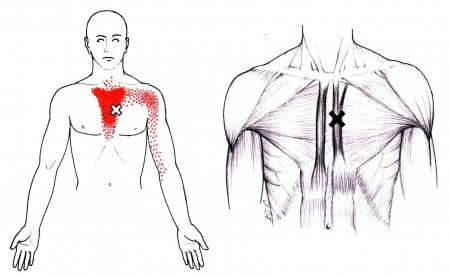Contents
Introduction
The chest in the body has many functions: it helps provide stability on the shoulders, helps protect the heart and lungs, and bears most of the weight of the rest of the upper body. The chest is home to the pectoralis (major and minor) and the serratus anterior muscles, providing mobility and compression to the chest. As the chest muscles protect the heart and lungs, the other muscles, known as the accessory muscles, aid the heart and lungs regarding respiratory and ventilation. In contrast, the primary chest muscles can not provide that function. The sternalis muscle is one accessory muscle that assists the heart and the lungs. Today’s article examines the sternalis muscle in the chest, how myofascial pain syndrome is associated with the sternalis muscle, and various techniques for managing myofascial pain syndrome on the sternalis muscle. We refer patients to certified providers specializing in chest pain therapies to aid many people suffering from myofascial pain syndrome associated with the sternalis muscle along the chest. We brief patients by referring them to our associated medical providers based on their examination when appropriate. We indicate that education is a great solution to asking our providers profound and complex questions at the patient’s request. Dr. Alex Jimenez, D.C., notes this information as an educational service only. Disclaimer
The Sternalis Muscle In The Chest
Have you been experiencing respiratory issues that are affecting your chest? What about feeling muscle tightness in the middle of your chest? Or are you experiencing radiating pain traveling down your elbow? These symptoms are often associated with pain caused by trigger points along the chest affecting the sternalis muscle. Studies reveal that the sternalis muscle is an anatomical variant along the anterior thoracic region of the body. The sternalis muscle is located right in the middle of the chest and is toward the end of the pectoralis muscles. “Myofascial Pain and Dysfunction,” written by Dr. Janet G. Travell, M.D., explained that the sternalis muscle often occurs bilaterally or unilaterally in the body and may attach itself either in the pectoralis muscle or the sternocleidomastoid. The sternalis muscle could even become a continuation of these muscles as well.

One of the unique functions of the sternalis muscle for the body is that it is an accessory muscle. An accessory muscle refers to various muscles that assist the breathing muscles. Since the sternalis muscle assists the other muscles as an accessory muscle, this muscle help opens the airways to allow more oxygen to the lungs. This muscle is extremely useful when it comes to exercising the body. However, this muscle is superficial and can succumb to various issues that affect the chest and internal organs.
Myofascial Pain Syndrome Associated With The Sternalis Muscle

Since the sternalis muscle is superficial, many issues can affect the middle of the chest and invoke pain-like symptoms that overlap and develop myofascial pain syndrome or trigger points in the sternalis. The symptoms associated with myofascial pain syndrome affecting the sternalis muscle are intense, deep pain that can occasionally cause soreness in the sternum. Studies reveal that since the sternalis is an accessory muscle, it can be overlooked, and symptomatic incidences can affect the chest and surrounding organs. To that point, symptoms like muscular imbalances, overuse tendinopathies, or neural compression syndromes can cause the sternalis muscle to ache and activate trigger points. When active trigger points affect the sternalis muscle, it correlates with myocardial infarction or angina pectoris mimicking cardiovascular disorders. Myofascial pain syndrome is tricky to diagnose, but it is treatable with various techniques that can manage the pain.
Massage Techniques For The Sternalis Muscle-Video
Have you been experiencing pain in the middle of your chest? Are you experiencing symptoms of cardiovascular disorders? Or does your chest hurts when you’re coughing? Myofascial pain syndrome or trigger points affecting the sternalis muscle are associated with many symptoms. Myofascial pain syndrome is a condition that affects the musculoskeletal system by causing the affected muscles to be overused and causing referred pain. Studies reveal that issues like myofascial pain syndrome begin to affect the chest wall cavity of the body; many patients think they have a cardiac disease causing greater impairment in their daily activities, causing emotional stress and a higher level of anxiety. All is not lost, though, as there are various techniques to reduce the pain and other chronic symptoms while managing myofascial pain syndrome on the sternalis muscle. The video above explains the sternalis muscle and shows different approaches to stretching and massaging the sternalis muscle on the chest.
Various Techniques For Managing Myofascial Pain Syndrome On The Sternalis Muscle

When a doctor examines the sternalis muscle, many individuals will often complain about experiencing chest and heart pain since the muscle is located in the front-middle of the chest. However, all is not lost, as various techniques can help relieve the pain along the sternalis muscle while managing myofascial pain syndrome. As stated earlier, trigger points can mimic other chronic conditions that can affect not only the muscle itself but the surrounding organs. Gently stretching the chest can help reduce the aches in the surrounding muscles and trigger point formation. Another technique that many people can incorporate is ischemic compression on the sternalis muscle combined with moist heat. The ischemic compression allows a sense of discomfort, but no pain should be inflicted to reduce pain symptoms and manage myofascial pain syndrome.
Conclusion
The sternalis muscle is located in the middle of the chest and helps the surrounding muscles to breathe and expand. This muscle works together with the pectoralis and the sternocleidomastoid muscle by attaching itself to these muscles in a unilateral or bilateral muscle. When traumatic forces or events affect the chest, this superficial muscle can be affected and develop myofascial pain syndrome that mimics cardiovascular disorders. Fortunately, various techniques like gentle chest stretch and ischemic compression can help manage trigger points and reduce pain in the chest.
References
Bell, Daniel J. “Accessory Muscles of Respiration: Radiology Reference Article.” Radiopaedia Blog RSS, Radiopaedia.org, 23 July 2022, https://radiopaedia.org/articles/accessory-muscles-of-respiration?lang=us.
Gruber, L, et al. “A Rare Case of a Symptomatic Sternalis Muscle: Ultrasonograpy and MRI Correlation.” Ultrasound International Open, © Georg Thieme Verlag KG, Nov. 2016, https://www.ncbi.nlm.nih.gov/pmc/articles/PMC5120977/.
Raikos, Athanasios, et al. “Sternalis Muscle: An Underestimated Anterior Chest Wall Anatomical Variant.” Journal of Cardiothoracic Surgery, BioMed Central, 16 May 2011, https://www.ncbi.nlm.nih.gov/pmc/articles/PMC3117696/.
Travell, J. G., et al. Myofascial Pain and Dysfunction: The Trigger Point Manual: Vol. 1:Upper Half of Body. Williams & Wilkins, 1999.
Verdon, François, et al. “Chest Wall Syndrome among Primary Care Patients: A Cohort Study.” BMC Family Practice, BioMed Central, 12 Sept. 2007, https://www.ncbi.nlm.nih.gov/pmc/articles/PMC2072948/.
Disclaimer
General Disclaimer, Licenses and Board Certifications *
Professional Scope of Practice *
The information herein on "Myofascial Pain Syndrome Causing Issues On The Sternalis Muscle" is not intended to replace a one-on-one relationship with a qualified health care professional or licensed physician and is not medical advice. We encourage you to make healthcare decisions based on your research and partnership with a qualified healthcare professional.
Blog Information & Scope Discussions
Welcome to El Paso's Premier Wellness and Injury Care Clinic & Wellness Blog, where Dr. Alex Jimenez, DC, FNP-C, a Multi-State board-certified Family Practice Nurse Practitioner (FNP-BC) and Chiropractor (DC), presents insights on how our multidisciplinary team is dedicated to holistic healing and personalized care. Our practice aligns with evidence-based treatment protocols inspired by integrative medicine principles, similar to those on this site and on our family practice-based chiromed.com site, focusing on naturally restoring health for patients of all ages.
Our areas of multidisciplinary practice include Wellness & Nutrition, Chronic Pain, Personal Injury, Auto Accident Care, Work Injuries, Back Injury, Low Back Pain, Neck Pain, Migraine Headaches, Sports Injuries, Severe Sciatica, Scoliosis, Complex Herniated Discs, Fibromyalgia, Chronic Pain, Complex Injuries, Stress Management, Functional Medicine Treatments, and in-scope care protocols.
Our information scope is multidisciplinary, focusing on musculoskeletal and physical medicine, wellness, contributing etiological viscerosomatic disturbances within clinical presentations, associated somato-visceral reflex clinical dynamics, subluxation complexes, sensitive health issues, and functional medicine articles, topics, and discussions.
We provide and present clinical collaboration with specialists from various disciplines. Each specialist is governed by their professional scope of practice and their jurisdiction of licensure. We use functional health & wellness protocols to treat and support care for musculoskeletal injuries or disorders.
Our videos, posts, topics, and insights address clinical matters and issues that are directly or indirectly related to our clinical scope of practice.
Our office has made a reasonable effort to provide supportive citations and has identified relevant research studies that support our posts. We provide copies of supporting research studies upon request to regulatory boards and the public.
We understand that we cover matters that require an additional explanation of how they may assist in a particular care plan or treatment protocol; therefore, to discuss the subject matter above further, please feel free to ask Dr. Alex Jimenez, DC, APRN, FNP-BC, or contact us at 915-850-0900.
We are here to help you and your family.
Blessings
Dr. Alex Jimenez DC, MSACP, APRN, FNP-BC*, CCST, IFMCP, CFMP, ATN
email: coach@elpasofunctionalmedicine.com
Multidisciplinary Licensing & Board Certifications:
Licensed as a Doctor of Chiropractic (DC) in Texas & New Mexico*
Texas DC License #: TX5807, Verified: TX5807
New Mexico DC License #: NM-DC2182, Verified: NM-DC2182
Multi-State Advanced Practice Registered Nurse (APRN*) in Texas & Multi-States
Multi-state Compact APRN License by Endorsement (42 States)
Texas APRN License #: 1191402, Verified: 1191402 *
Florida APRN License #: 11043890, Verified: APRN11043890 *
License Verification Link: Nursys License Verifier
* Prescriptive Authority Authorized
ANCC FNP-BC: Board Certified Nurse Practitioner*
Compact Status: Multi-State License: Authorized to Practice in 40 States*
Graduate with Honors: ICHS: MSN-FNP (Family Nurse Practitioner Program)
Degree Granted. Master's in Family Practice MSN Diploma (Cum Laude)
Dr. Alex Jimenez, DC, APRN, FNP-BC*, CFMP, IFMCP, ATN, CCST
My Digital Business Card
Licenses and Board Certifications:
DC: Doctor of Chiropractic
APRNP: Advanced Practice Registered Nurse
FNP-BC: Family Practice Specialization (Multi-State Board Certified)
RN: Registered Nurse (Multi-State Compact License)
CFMP: Certified Functional Medicine Provider
MSN-FNP: Master of Science in Family Practice Medicine
MSACP: Master of Science in Advanced Clinical Practice
IFMCP: Institute of Functional Medicine
CCST: Certified Chiropractic Spinal Trauma
ATN: Advanced Translational Neutrogenomics
Memberships & Associations:
TCA: Texas Chiropractic Association: Member ID: 104311
AANP: American Association of Nurse Practitioners: Member ID: 2198960
ANA: American Nurse Association: Member ID: 06458222 (District TX01)
TNA: Texas Nurse Association: Member ID: 06458222
NPI: 1205907805
| Primary Taxonomy | Selected Taxonomy | State | License Number |
|---|---|---|---|
| No | 111N00000X - Chiropractor | NM | DC2182 |
| Yes | 111N00000X - Chiropractor | TX | DC5807 |
| Yes | 363LF0000X - Nurse Practitioner - Family | TX | 1191402 |
| Yes | 363LF0000X - Nurse Practitioner - Family | FL | 11043890 |








